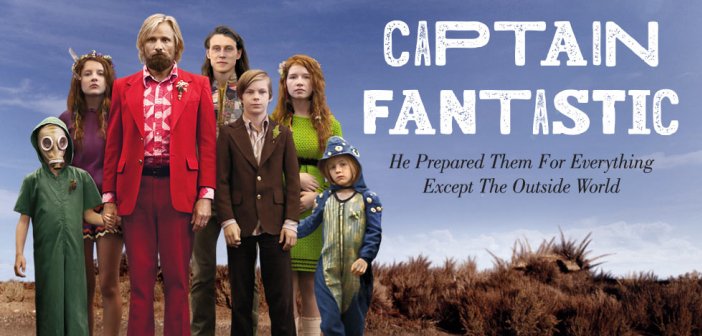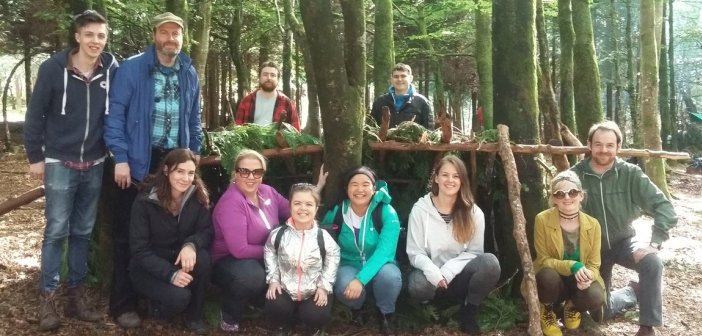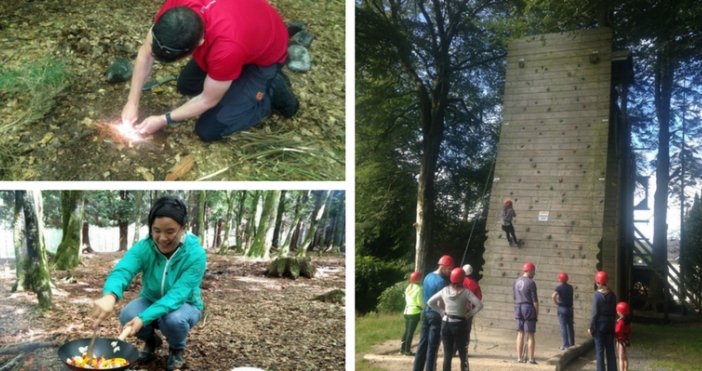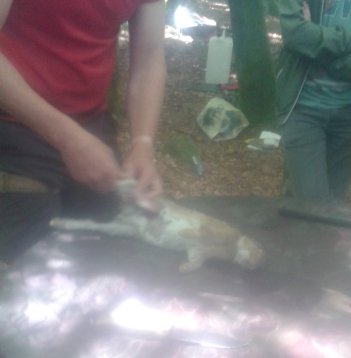How to Survive in the Wild – Captain Fantastic Style
Having written a review on the excellent Captain Fantastic starring Viggo Mortensen, I was asked to attend a press trip designed to help promote the movie. The drama centres on a survivalist family who live off the grid in the forest of the Pacific Northwest. The opening act portrays the clan’s daily routine – hunting wild animals, dismembering their prey for food, scaling massive, jagged cliffs etc. etc. Upon this venture, the various bloggers willing to give up their Saturday would learn and attempt to replicate the very physical feats of Mortensen and his fictional family.

Now to give context to this story, I am the furthest thing from an outdoors type. My ideal afternoon is spent watching movies and an ideal night is spent drinking too much alcohol. In terms of survivalism, I am one hundred per cent sure I’d die first in a war and the closest I have come to spending time in the wilderness was the three times I went to Electric Picnic. The closest I have to come to foraging was finding a table in The Living Room when Ireland played in the Euros. Still, I have never been one to turn my back on a challenge. Having just completed college and as a struggling writer, a certain ennui was beginning to settle in. This day could be my attempt to replicate the journalistic style of Hunter S. Thompson or Norman Mailer (quite a stretch I know, but a man can dream). So, I accepted and on a warm Saturday morning I awoke and made my way into town.
The bus collected myself and ten others who were attending from Custom House Quay and we began our journey to Wicklow. The enthusiastic group organiser did her best to create a sense of excitement. However, I didn’t have time to get a coffee so I needless to say, I wasn’t in the mood to foster team relations.
When we arrived at our destination, the sun was splitting the stones and the hills that surrounded us looked like they were straight out of a modern western like The Assassination of Jesse James or The Three Burials of Melquiades Estrada. I commented on this to one of the survival trainers who then told me that the area was actually used in the making of Braveheart. When production finished, the crew left everything from the film behind. However, the person who owned the area did not want it to become a tourist spot so they promptly removed everything. Obviously not a film buff.

The place where we were to spend the day was The Kippure State, a survivalist camp which also doubles as a wedding facility. While various groomsmen were taking swigs out of their secret flasks, I began my first attempt at being a real outdoors man. This involved scaling down a wooden feature that was around thirty feet in height. In order to tie me to a harness, I needed to put on what can only be described as a futuristic jock strap on over my clothes. As I ascended the monument, the trainer demonstrated how to scale down. It involved placing one’s legs onto the edge of the thirty-foot drop and climbing down.
As he described the process, my legs started to go numb. Thirty feet is not a lot in the grand scheme of civilisation but imagine jumping down off the roof of a two story house. It’s quite unsettling. The scared, little boy in my head was shouting “Tap out! Tap out!”. But there were others present and I didn’t want to look like a fool. So I pulled myself together, taking control of my trembling legs and knocking knees. After watching the person in front of me perform the action without much bother, I went next.
To my surprise, it wasn’t so difficult. The hardest part was standing on the edge for a few minutes. Then, once one begins to descend, one realises how secure the harness is (the person going down holds one and the trainer above holds the other). I’ll happily admit I was not very elegant. My hands started to get rope burn so I jerkily kicked down as quickly as possible. The young woman, after me, who organised the event, effortlessly made her way to the ground from the monument in about fifteen seconds with more grace than I had managed.
Our second task was to learn about foraging for water if stranded in the woods. The best way to make sure water is safe to drink is to boil it as that kills bacteria or disease left by animals. However, in order to do that one needs fire. If fire is unavailable, charcoal is the next safest option. By cutting the end of a bottle, one is meant to fill the implement in this order with charcoal, moss, sand or small rocks and more moss. This forms a filter whereby dirty water poured in becomes clean to drink. If a bottle is unavailable, one can bury a hole and place anything in it that can hold water. Around the hole, pour the dirty water. The land will then function as a natural filter and eventually the H2O will find its way to the hole. If one is truly desperate, urine can even be filtered using these methods, though the survivalist told us there will always be “that tang”. I knew what he meant. I’ve had lager like that before.

Next was making fire. They told us is that if you were to go into the woods, always bring matches or a lighter. Birch is the best leaf to burn because there is natural oil in the leaf. You then place the burning leaf on a fire pit (a collection of sticks that are used as kindling). Small twigs are best to use first and then one slowly adds bigger and bigger sticks, while making sure the fire has plenty of oxygen. If the fire is ever about to die out and you need it, blow on the remaining sparks. The air allows the fire to spread again. The survivalists also showed us a neat trick. If you rub the ends of a good battery with steel wool, sparks emerge immediately. I excitedly told my mam this when I came home. To which we had this exchange:
Me: If you’re ever stuck without a fire, rub steel wool and a battery together. Starts one right away.
Mam: When are you ever gonna have those things in the wilderness?
Me: If I was going now, I’d bring them.
Mam: But then you could just bring matches and a lighter.
Me: …
Using what we learned, we built our own fires. The survivalists left us food out to prepare. Thankfully, one of the bloggers main area of expertise was cooking. He prepared delicious wraps of fried chicken, tomato, mushrooms and peppers and then followed with amazing fried sausages and leek. As we ate, the survivalists told us about their military experience. One time, their patrol, as part of a training exercise, abandoned them in the jungles of East Timor. There, they had to survive in the blistering heat for twenty-four days. (I experience danger in my work too. I almost fell down the IFI’s stairs just last week).
Next was the disgusting part. One of the survivalists brought out a dead rabbit (they had killed it with a shot-gun earlier that day). At this point, a female blogger dressed colourfully quirky as if she was in a Wes Anderson movie asked if she could sit this out as she was vegan. While she chewed on a leaf, the man, with a hatchet, cut the lower half of each leg off the rabbit I’ll refer to as Lucky for now on. Then they cut off the head and peeled the skin off Lucky’s back in a way which resembled a sock coming off a foot. At this point there were two Lucky’s on the table – Lucky’s outside fur and Lucky’s inside muscle and skeleton.

He then sliced into the rabbit’s belly and between its hind legs exposing the small intestine. He stressed the importance of not puncturing the bile-green gland in Lucky’s liver. The meat would still be edible if this happened but it would taste horrific. Also, it’s important to finger the anus of the animal to remove any excrement still lodged. Following this, everything left could be eaten and would taste gamey (I would think anything would be gamey after that experience). Unfortunately, the fragments of bullets that hit Lucky, pierced his liver so we could not taste him. However, I think even if it hadn’t, there would have still been some safety regulation preventing us from doing so.
Our last exercise was building a shelter. It was explained to us that there were three types – a lean to, a teepee and a frame. We built a lean to because it’s the easiest to craft quickly. All it needs are large branches, a lot of leaves (preferably pine) and two large trees to rest against. One strong branch is placed horizontally in the air between two trees. Then the other branches are left leaning upon the stronger one, forming a roof. The leaves are important because damp ground sucks heat out of the body sleeping upon it. Therefore, leaves work like a blanket – separating one from the earth. They are also vital for deflecting rain off the roof so it’s essential to provide leaf covering on one’s branches. Perhaps I’m over-zealous but after my team and I completed the task, I’d have happily spent the night in my homely new shack.
As we waited for the bus to pick us up at 5 o’clock, we all tried our hands at archery. Again, the woman who schooled everyone during the scaling portion of the day, was the best at this, hitting the board frequently with her arrow. She probably would have done okay in harsh landscapes. I, on the other hand, felt keenly aware that I’m a city boy at heart and that rabbits need not fear me, no matter how gamey they may be. I enjoyed the experience and for next Electic Picnic, I’m packing steel wool and a battery and a bunch of birch. I’m drawing the line at drinking urine, however.
Featured Image Credit

